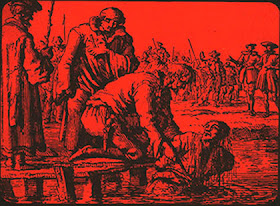"Anabaptists were the largest of so-called millenarian groups, who believed that the end of the world was near. Anabaptism developed from the work of Conrad Grebel, (1498-1526) a humanist and former student of Zwingli who saw nothing biblical about infant baptism.
He noted that in Luke’s Gospel, John the Baptist had baptized Jesus as an adult. He believed that the church should be a voluntary community of believers. In this regard, he disagreed with Zwingli, who had advocated state sponsorship of religion. At a meeting in 1523, he suggested that Zwingli abandon political control over religion; but Zwingli wasn’t interested.
He noted that in Luke’s Gospel, John the Baptist had baptized Jesus as an adult. He believed that the church should be a voluntary community of believers. In this regard, he disagreed with Zwingli, who had advocated state sponsorship of religion. At a meeting in 1523, he suggested that Zwingli abandon political control over religion; but Zwingli wasn’t interested.
Grebel and those who followed him then formed their own church which they modeled after the Church established in the Acts of the Apostles. There was a simple form of worship in private homes, and the Lord’s Supper was considered a solemn remembrance. They attempted to follow the Sermon on the Mount as closely as possible.
Then, in January, 1525, Grebel caused a tremendous stir when he performed an adult baptism on one George Blaurock, was a former priest, who in turn baptized others. Since the first group baptized as adults had previously been baptized as Catholic children, their enemies called them Anabaptists, from a Greek word meaning “rebaptism. Rebaptism was prohibited by the Catholic Church under penalty of death. The Anabaptists themselves, who believed that they were destined to suffer as Christ and his disciples had suffered, called themselves Christians,” “Saints,” or simply “Brethren.”
An important element of Anabaptist belief was that the law of man had no force over those whom God had served. Faith took precedent over the law. This was a doctrine known as antinomianism. Some even argued that faith took precedence over marital vows.
Anabaptists were pacifists at heart, but were persecuted heavily by both Protestants and Catholics.
Luther pronounced them “wolves in sheep’s clothing.” Even Zwingli condemned them. Grebel and his followers were ordered to leave Zurich, and rebaptism was made punishable by death. Grebel was imprisoned, but escaped five months later. He died shortly thereafter of plague. Other followers were burned at the stake, or drowned. Drowning was an intentional irony proposed by the Holy Roman Emperor, Charles V. It was a sort of “third baptism.” Drowning was frequently used to execute women. Even so, the movement grew as others were impressed by the courage of the “suffering saints.”
Luther pronounced them “wolves in sheep’s clothing.” Even Zwingli condemned them. Grebel and his followers were ordered to leave Zurich, and rebaptism was made punishable by death. Grebel was imprisoned, but escaped five months later. He died shortly thereafter of plague. Other followers were burned at the stake, or drowned. Drowning was an intentional irony proposed by the Holy Roman Emperor, Charles V. It was a sort of “third baptism.” Drowning was frequently used to execute women. Even so, the movement grew as others were impressed by the courage of the “suffering saints.”
Anabaptists believed that one was only the steward, not the owner of private property. Christians should be compelled by brotherly love to share with anyone in need. Among the groups which originated with the Anabaptists were the Hutterites (named for Jacob Hutter) who believe in the “community of goods; and the Mennonites. Modern day Amish follow a similar line of thinking.
In 1532, a radical group of Anabaptists took over the town of Mǖnster, Germany by election. Their leader, one John of Leyden, convinced the town elders to allow polygamy, thereby establishing “endless links of kinship.” He led the way by taking sixteen wives. All books except the Bible were burned; and Lutherans and Catholics were murdered. After sixteen months, troops sent by Lutheran and Catholic princes stormed the town and tortured the town leaders to death. A number of those tortured were women. Their corpses, mutilated by torture, were placed in an open cage in the church steeple. It remains there to this day." Z,A&C
...and they of Jerusalem,
and were all baptized of him in the river of Jordan,
confessing their sins.
Mark 1:5
